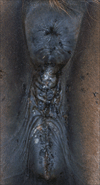Equine post-breeding endometritis: A review
- PMID: 21851709
- PMCID: PMC3113865
- DOI: 10.1186/2046-0481-61-3-163
Equine post-breeding endometritis: A review
Abstract
The deposition of semen, bacteria and debris in the uterus of the mare after breeding normally induces a self-limiting endometritis. The resultant fluid and inflammatory products are cleared by 48 hours post cover. Mares that are susceptible to persistent post-breeding endometritis (PPBEM) have impaired uterine defence and clearance mechanisms, making them unable to resolve this inflammation within the normal time. This persists beyond 48 hours post-breeding and causes persistent fluid accumulation within the uterus. Mares with PPBEM have an increased rate of embryonic loss and a lower overall pregnancy rate than those without the condition. To enhance conception rates, mares at high risk need optimal breeding management as well as early diagnosis, followed by the most appropriate treatment. This article reviews the pathogenesis, diagnosis and treatment of PPBEM and the management of affected mares.
Figures



References
-
- Barbacini S, Necchi D, Zavaglia G, Squires EL. Retrospective study on the incidence of postinsemination uterine fluid in mares inseminated with frozen/thawed semen. Journal of Equine Veterinary Science. 2003;23:493–496. doi: 10.1016/j.jevs.2003.10.003. - DOI
LinkOut - more resources
Full Text Sources
Other Literature Sources

